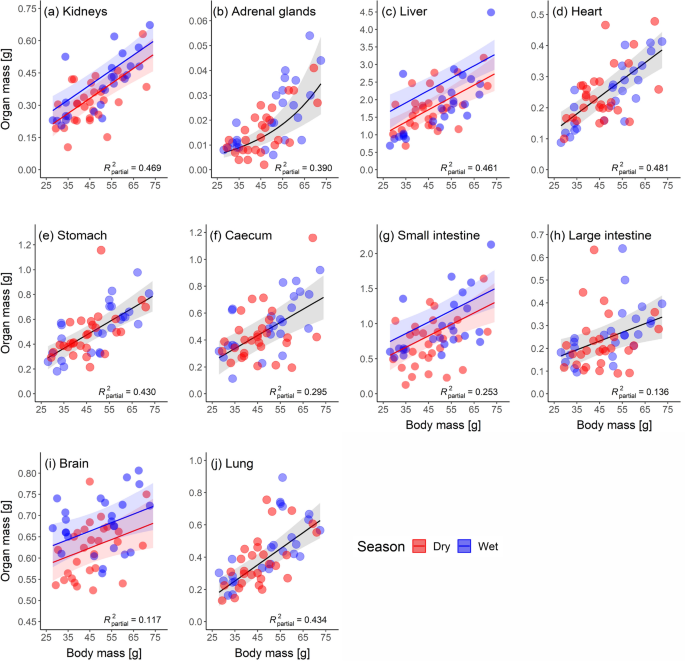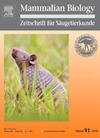African striped mice have relatively smaller brains in the food deprived dry season than in the wet season
IF 1.9
4区 生物学
Q1 ZOOLOGY
引用次数: 0
Abstract
Abstract The ability to alter the mass of energetically consumptive organs in response to seasonal variation in nutritional access has been demonstrated in several species from temperate climates, but less so from other climate zones. We predicted that adult striped mice ( Rhabdomys pumilio ) from the Succulent Karoo semi-desert in South Africa have lower organ masses during the hot summer dry season with low food availability ( n = 28) when compared to the food-rich wet season ( n = 25) as a possible adaptation to reduced energy expenditure. Food availability in the wet season was more than twice than that of the dry season. Body mass was positively correlated with most organ masses considered, except for the spleen. Mandible length, as a non-plastic measure of body size, was positively correlated with the mass of heart and stomach. Relative to body mass and to mandible length, kidneys and the small intestine were heavier in the wet season than during the dry season in both sexes. Liver masses were greater in females (but smaller in males) during the wet season, possibly due to increased female reproductive investment during this season. Both sexes had relatively heavier brains (by 9.6% on average) during the wet season than during the dry season, which is the first indication of the Dehnel phenomenon in a rodent, in a subtropical climate, and in the southern hemisphere. Future studies will have to test whether this change in brain size is reversible. Having relatively smaller brains during the dry season could be a mechanism to reduce energy consumption. In conclusion, our study indicates that striped mice may save energy during the food restricted dry season by reducing energetically expensive organ masses, including brain mass.

非洲条纹鼠在食物匮乏的旱季比在雨季的大脑相对较小
在温带气候的几个物种中,已经证明了能量消耗器官的质量随营养获取的季节变化而变化的能力,但在其他气候带则较少。我们预测,与食物丰富的雨季(n = 25)相比,来自南非多肉的卡鲁半沙漠的成年条纹鼠(Rhabdomys pumilio)在炎热的夏季旱季(n = 28)和低食物供应(n = 28)具有更低的器官质量,这可能是为了适应减少的能量消耗。雨季的食物供应量是旱季的两倍多。除脾脏外,体重与大多数器官质量呈正相关。下颌骨长度作为衡量体型的非塑性指标,与心脏和胃的质量呈正相关。相对于体重和下颌骨长度,肾脏和小肠在湿季均比干季重。在雨季,雌性的肝脏肿块较大(但雄性较小),可能是由于雌性在这个季节增加了生殖投资。在雨季,雄性和雌性的大脑都比旱季重(平均重9.6%),这是在亚热带气候和南半球的啮齿动物中首次出现德内尔现象。未来的研究必须测试这种大脑大小的变化是否可逆。旱季大脑相对较小可能是减少能量消耗的一种机制。总之,我们的研究表明,条纹鼠可能通过减少能量昂贵的器官质量,包括脑质量,在食物受限的旱季节省能量。
本文章由计算机程序翻译,如有差异,请以英文原文为准。
求助全文
约1分钟内获得全文
求助全文
来源期刊

Mammalian Biology
生物-动物学
CiteScore
3.30
自引率
12.50%
发文量
127
审稿时长
10.1 weeks
期刊介绍:
Mammalian Biology (formerly Zeitschrift für Säugetierkunde) is an international scientific journal edited by the Deutsche Gesellschaft für Säugetierkunde (German Society for Mammalian Biology). The journal is devoted to the publication of research on mammals. Its scope covers all aspects of mammalian biology, such as anatomy, morphology, palaeontology, taxonomy, systematics, molecular biology, physiology, neurobiology, ethology, genetics, reproduction, development, evolutionary biology, domestication, ecology, wildlife biology and diseases, conservation biology, and the biology of zoo mammals.
 求助内容:
求助内容: 应助结果提醒方式:
应助结果提醒方式:


